
The All-New Renault Duster is Here
After a two-year absence from the South African market, the mighty Renault Duster is back...
 12 March 2025
12 March 2025 
So, you’ve heard of the Big Five, Africa’s most iconic arrangement of animals. But have you ever heard of Kruger National Park’s Big Six? It’s a group of spectacular birds that, much like the Big Five, inspire awe and wonder in everyone from avid birders to first-time safari travellers. In fact, these six species “mirror” Big Five behaviour in various ways.
All told, these are the six birds that visitors to Kruger National Park are most likely to want to see. They’re big, bold, and somewhat steeped in legend, making them the perfect ambassadors for South Africa’s oldest and most famous national park. On the other hand, they’re also threatened by human activity, meaning you’re most likely to spot them in protected areas. Let’s take a closer look at these avian superstars.
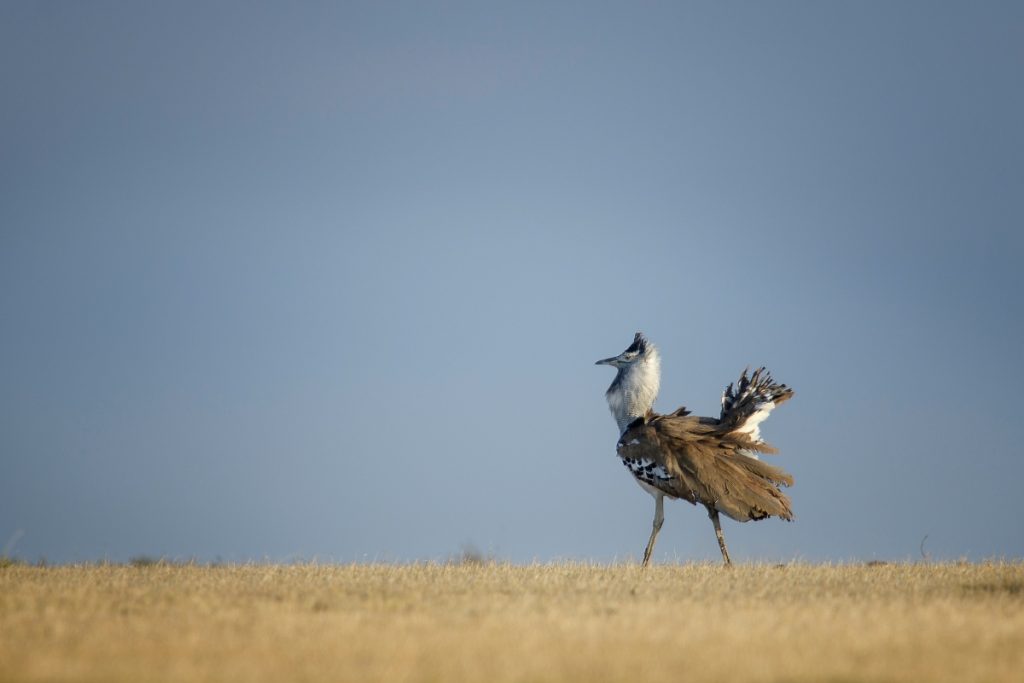
Photo: Getty
The kori bustard (Ardeotis kori) is, according to some sources, the heaviest flying bird in the world. Weighing in at up to 20 kg, with a wingspan of up to 2.75 m, these tall birds stand out in grasslands as they search for large insects and small animals like lizards, snakes, and rodents. Although they can fly, they spend more than two thirds of their time on foot. They’re also easily spooked and will generally move off quietly if they think they’re in danger.
In Kruger National Park, you’ll find the kori bustard in open grassy areas, on arid plateaus, and in sparse bushveld. Because of their size, they’re hard to miss, especially when you’re driving along long stretches of road. You’re less likely to find them in heavily wooded areas, mainly because they need a lot of room to take flight.
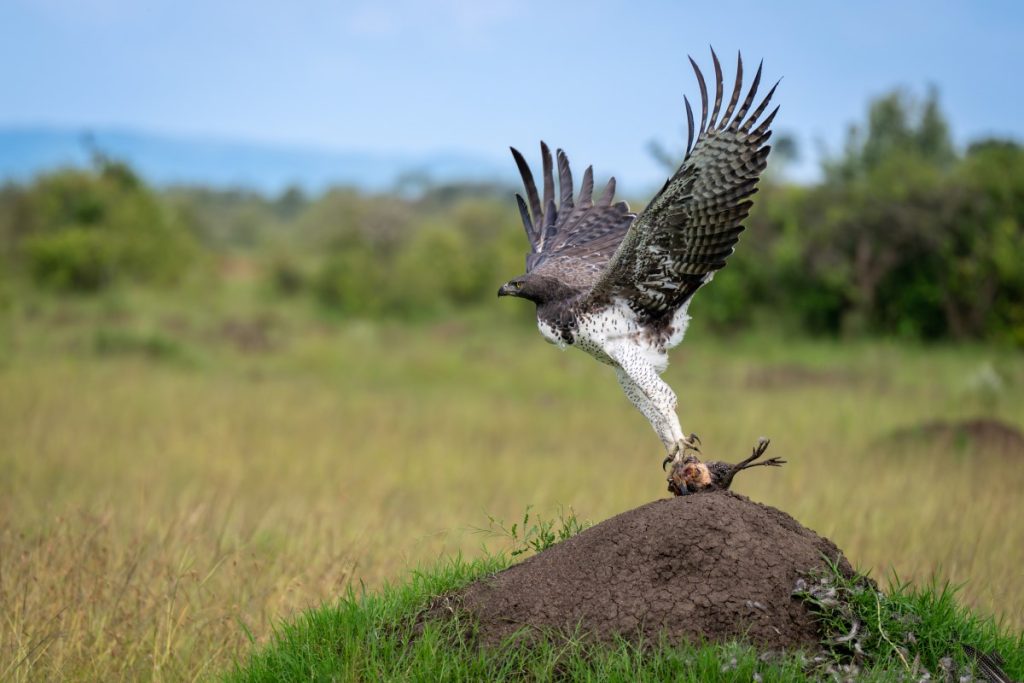
Photo: Getty
Meet the joint-largest eagle in Africa: the martial eagle (Polemaetus bellicosus). It’s one of Kruger National Park’s most prized bird sightings, and once you see one in the wild, you’ll understand exactly why. Few birds of prey in Africa come close to the sheer size and presence of this apex predator. It boasts the fourth-longest wingspan of any eagle at up to 2.4 m and weighs up to 4.8 kg. It’s so big, in fact, that it often hunts other predators like monitor lizards, jackals, and the cubs of lions, leopards, and cheetahs. Even more impressively, it’s fully capable of taking down small adult antelopes like dik-diks, klipspringers, duikers, and steenboks. Birds aren’t safe, either. Adult martial eagles regularly hunt kori bustards in long, drawn-out battles.
Kruger National Park is home to a relatively healthy population of martial eagles, especially considering that it’s an endangered species. Sadly, farmers and game wardens consider the eagle a pest, largely as a result of exaggerated reports of attacks on livestock. This persecution continues across much of sub-Saharan Africa, but in Kruger, it’s found a safe haven.
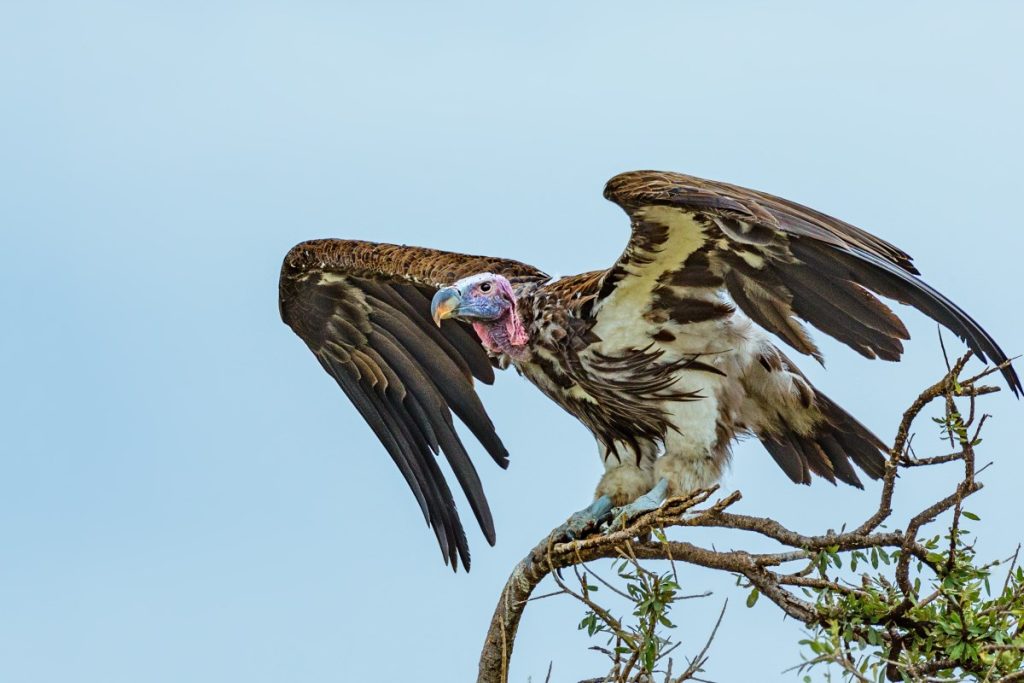
Photo: Getty
Vultures are typically large birds, but the lappet-faced vulture (Torgos tracheliotos) stands out from the rest, especially in Africa. It has the longest body length (1.15 m) and wingspan (2.9 m) of any African vulture, and females can weigh up to 13.6 kg. Its most striking feature is its head, with a reddish face and distinctive pink skin folds that run run down onto its neck. The huge, hooked beak isn’t for show – it helps the vulture carve through animal carcasses with ease, and the bald head keeps it from getting caked in blood. The beak is so effective, in fact, that hyenas will often wait for the vultures to eat first before digging into a much easier meal.
Like other birds in the Big Six, the lappet-faced vulture is endangered. Over the past century, it has gone extinct across much of its historical range, including areas like the Western Cape, Eastern Cape, and in some parts of Mozambique. In some places, farmers deliberately poison animal carcasses to kill vultures and other scavengers, even though there’s little evidence to suggest that they actually attack livestock. Kruger National Park offers these birds safety from human persecution, and here, they can revel in their role as the “undertakers” of the bush.
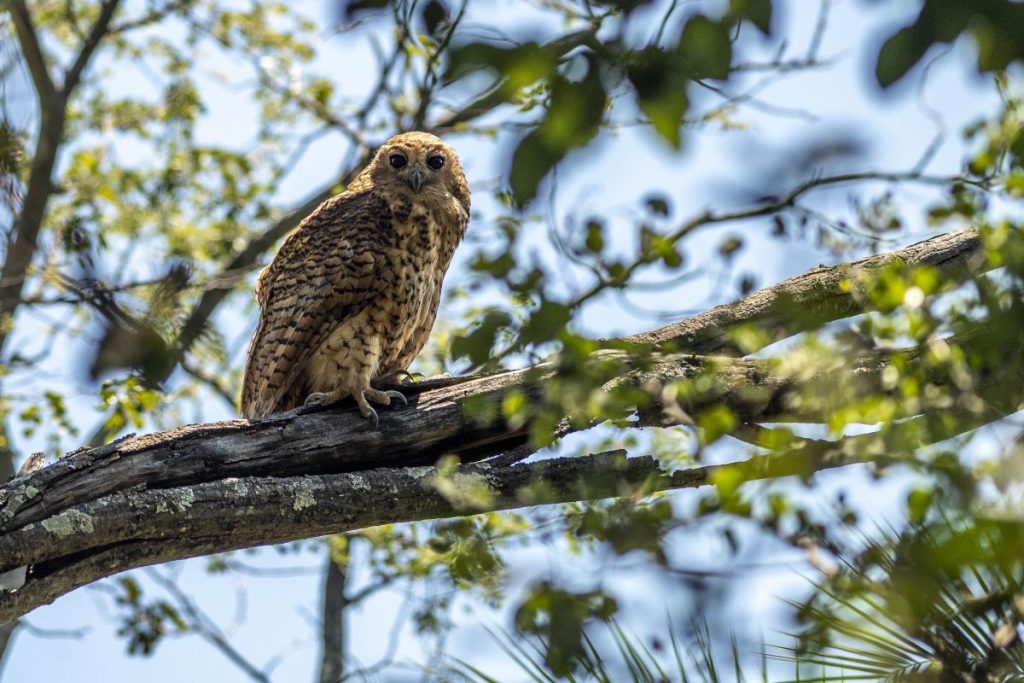
Photo: Getty
Pel’s fishing owl (Scotopelia peli) is a large, striking owl species found in sub-Saharan Africa, typically near slow-moving rivers, lakes, and swamps. Recognisable by its tawny-orange plumage and distinctive dark eye patches, this highly elusive bird is primarily nocturnal, making it difficult to spot in its natural habitat. This also makes it something of a “Holy Grail” for birders visiting areas like Kruger National Park. It has a wingspan of about 1.5 m, yet it flies almost silently, a trait that aids in its hunting.
Unlike many owls, Pel’s fishing owl feeds primarily on fish, as its name suggests. It uses its sharp talons to snatch prey from the water, often hunting at dusk or during the night when fish come closer to the surface. Its large eyes and acute hearing allow it to detect even the faintest ripples in the water. This is often the best time to spot them perched alongside waterways. In Kruger, they tend to stick to specific areas.
“The best way to see them is to go on either the Nyalaland or Olifants Wilderness Trails, or do night drives from Olifants Rest Camp,” SANParks says. “Balule Camp is also a potential place to see them, as is driving in the Pafuri region along the Levuvhu and being lucky enough to find one at roost.”
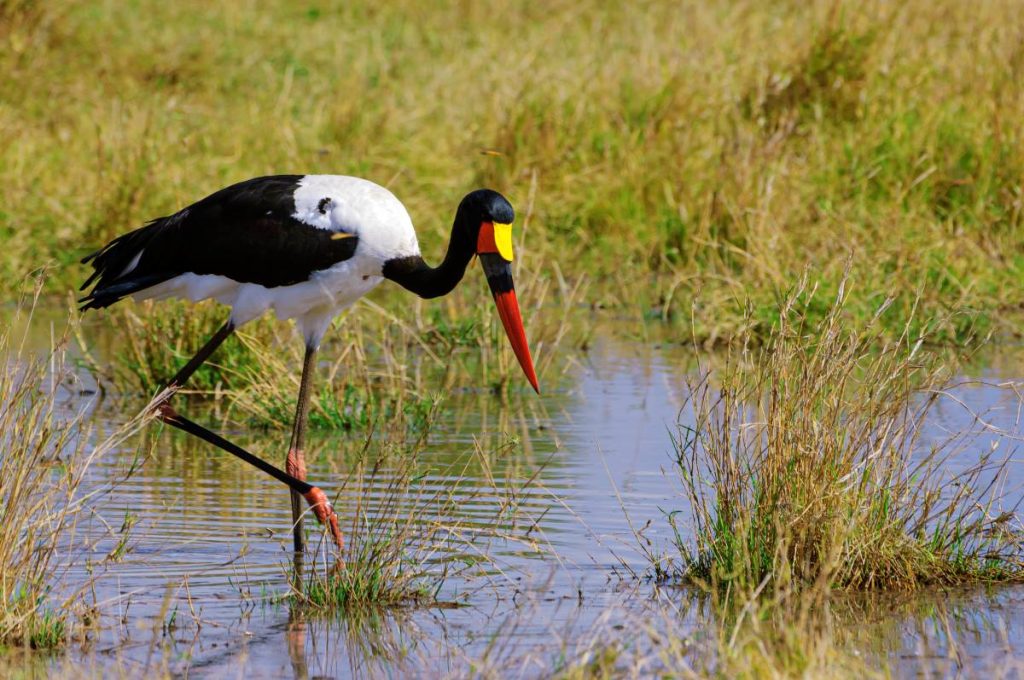
Photo: Getty
The saddle-billed stork (Ephippiorhynchus senegalensis) is one of Africa’s most striking and tallest storks, often found in wetlands, rivers, and floodplains. Its name comes from the bright yellow saddle-shaped shield at the base of its long, red-and-black bill. The bird’s bold black and white plumage, combined with its colourful bill, makes it easy to identify in its preferred habitats across sub-Saharan Africa.
Standing up to 1.5 m tall with a wingspan of nearly 2.5 m, the saddle-billed stork is a proficient hunter that’s difficult to confuse with other large stork-like birds. It feeds on a variety of aquatic prey, including fish, frogs, and small reptiles, which it catches with quick jabs of its sharp bill. These storks are usually solitary or found in pairs, and they’re known for their graceful movements in shallow waters as they search for food. Although not currently considered threatened, the saddle-billed stork is sensitive to habitat destruction, particularly the draining of wetlands. Despite being regularly spotted in Kruger National Park, they’re actually quite rare.
“Interestingly, it is estimated that there are only between 25 and 30 breeding pairs of saddle-bills in the park, plus a handful of non-breeding individuals,” SANParks explains. “However, because they are so large and striking in appearance and are very prominent along major water points, visitors regularly see them. But these numbers make them far rarer and more threatened than animals such as cheetah and wild dog, not to mention the Big Five.”
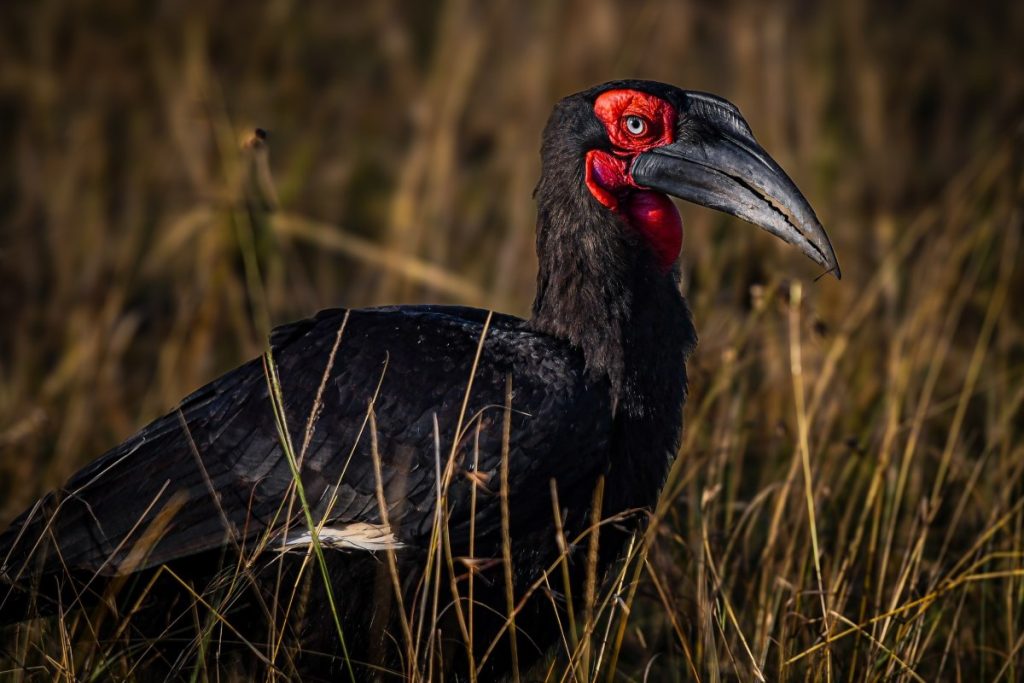
Photo: Getty
The southern ground hornbill (Bucorvus leadbeateri) is a large, charismatic bird native to the savannahs, grasslands, and woodlands of southern Africa. Distinguished by its striking appearance, this hornbill has black plumage, vivid red facial skin, and a large, curved beak. It is one of the largest hornbill species, standing up to 1.3 m tall and weighing around 6 kg. Males have more extensive red facial colouring, while females feature a patch of blue on their throats.
Unlike most hornbills, which are arboreal, the southern ground hornbill spends most of its time on the ground foraging for prey. It feeds on a wide variety of animals, including insects, small mammals, reptiles, and even other birds. With strong, powerful beaks, these birds can break open hard shells or dig into the ground in search of food. They live in family groups and are known for their loud, booming calls, which can carry over long distances and are often heard at dawn.
Southern ground hornbills are classified as vulnerable due to habitat loss, persecution, and slow breeding rates. They typically lay only one egg every few years, and raising young is a cooperative effort involving multiple birds within the group. If you pass by notice boards at Kruger National Park rest camps, you might see a poster about these “terror birds” highlighting the threats they face and what you can do to help.
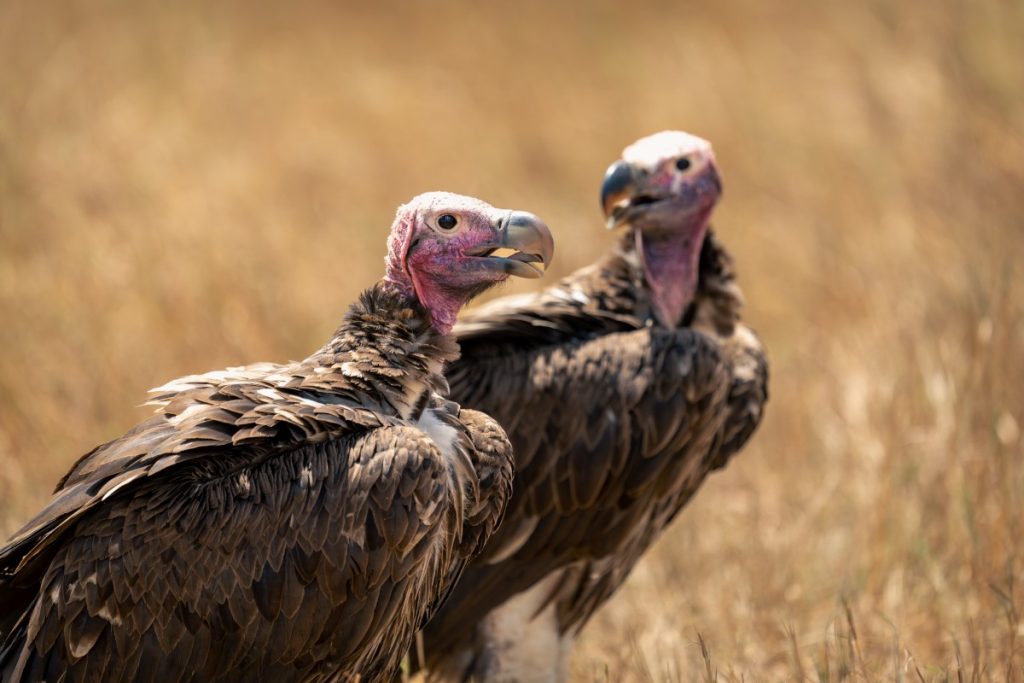
Photo: Getty
There you have it: Kruger’s Big Six birds in all their glory. These hunters are some of the most recognisable birds in all of Africa, and while you might have to search hard to find species like Pel’s fishing owl, you’ll have plenty of fun trying to tick them off your bird list. Remember to chat to park rangers when you visit Kruger National Park as they can often point you in the right direction! Then, all that’s left to do is climb back into your car or 4×4 from Drive South Africa and embark on your Big Six birding safari. Be sure to check out all our rental offerings, whether you’re looking for a frugal hatchback, a luxury SUV, or a camping-equipped 4×4.